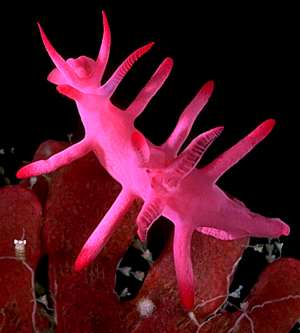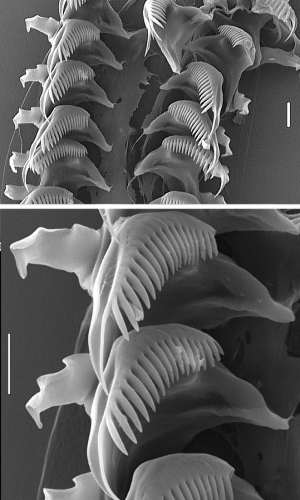

Okenia hallucigenia
Rudman, 2004
Order: NUDIBRANCHIA
Suborder: DORIDINA
Superfamily: ANADORIDOIDEA
Family: Goniodorididae
DISTRIBUTION
Northern Australia from Western Australia (Kimberley, Exmouth Gulf), Northern Territory, Queensland, central New South Wales.
PHOTO
Upper: on bryozoan food colony, Pleurotoichus clathratus, Halifax Park, Port Stephens, New South Wales, July 1986. 18mm long. AM C150357. Photo: Bill Rudman. Lower: SEM of radula showing part of whole ribbon (upper) and section of left side of ribbon (lower) showing large denticulate inner teeth and small reduced, plate-like outer teeth. North Solitary Is., Coffs Harbour, New South Wales, Australia, 17 January 1989, AM C157164. Scale bar = 10 µm. Photos: A.C. Miller.
NOTE: This species has previously been called Hopkinsia sp. on the Forum.
The animal is very elongate with a high profile and completely lacks any sign of a mantle edge. There are 4 prominent, very large, lateral papillae on each side of the body. The anterior papilla on each side sits in front of the adjacent rhinophore, and points forward. It is somewhat smaller than the 3 other lateral papillae on each side which point outwards and somewhat upwards. They are quite rigid and so are not as mobile and flexible as the papillae of many other species of Okenia with long papilla. There is one other mantle papilla, and it sits in the dorsal midline, just in front of the gills. There are up to 5 simple gills arranged in arch around the anal papilla. The rhinophores are long and tapering. The club, with up to 16 lamellae, occupies the upper two-thirds of the rhinophore. The head is very distinctive, with a wide bilobed 'oral veil' at least twice the width of the body. At times the lateral tips of the head can extend into tentacular foot corners. This species is named for its superficial likeness to the Burgess Shale 'onycophoran' fossil, Hallucigenia sparsa Morris, 1977, as reconstructed by Lars Ramsköld (1992). The whole of the animal is bright pink except for the tips of the mantle processes, the gills, and the rhinophores which are a deeper, redder shade of the same colour.
The radula is very similar in shape to that of O. kondoi. The inner teeth have a broad base and a blade which ends in a bicuspid tip. A medio-dorsal groove runs down the distal half of the tooth. There are up to 16 very long denticles along the cutting edge of the tooth. The much smaller outer teeth have a broadly quadrangular shape with up to 3 or 4 remnant cusps.
Okenia hallucigenia is often found with the very similar looking Okenia stellata on the bryozoan Pleurotoichus clathratus. This pair of species is matched by another pair of similarly shaped and coloured species (O. nakanotoensis, O. kondoi) which are reported from southern Japan, the Marshall Ids and the Philippines. Okenia kondoi is very similar to Okenia hallucigenia in external shape and radular morphology. Externally, O. kondoi appears to be even more cylindrical in shape than O. hallucigenia, its diameter matching that of the cylindrical branches of the bryozoan on which it lives and feeds. It also differs from O. hallucigenia in its colour pattern, with the bottom half of each papilla being creamy white. Okenia hallucigenia differs from O. stellata in the number of lateral papillae, radular morphology, and details of colour pattern. Observations from Western Australia, Queensland and New South Wales all note its association with the bryozoan Pleurotoichus clathratus.
-
Rudman, W.B. (2004) Further species of the opisthobranch genus Okenia (Nudibranchia: Goniodorididae) from the Indo-West Pacific. Zootaxa, 695: 1-70
Rudman, W.B., 2004 (December 21) Okenia hallucigenia Rudman, 2004. [In] Sea Slug Forum. Australian Museum, Sydney. Available from http://www.seaslugforum.net/factsheet/okenhall
Related messages
-
Re: Okenia hallucigenia from sthn Queensland
From: Gary Cobb, November 11, 2008 -
Okenia hallucigenia from sthn Queensland
From: Gary Cobb, November 10, 2008 -
Okenia hallucigenia ? from Port Stephens
From: Leanne & David Atkinson, November 7, 2008 -
Hopkinsia feeding on Pleurotoichus
From: Phil Bock, August 26, 1999
